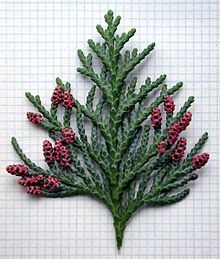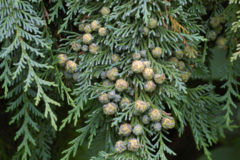- Chamaecyparis lawsoniana
-
Lawson's Cypress 
Lawson's Cypress foliage with cones: immature seed cones below, pollen cones above Conservation status Scientific classification Kingdom: Plantae Division: Pinophyta Class: Pinopsida Order: Pinales Family: Cupressaceae Genus: Chamaecyparis Species: C. lawsoniana Binomial name Chamaecyparis lawsoniana
(A. Murray) Parl.Chamaecyparis lawsoniana is a cypress in the genus Chamaecyparis, family Cupressaceae, known by the name Lawson's Cypress in the horticultural trade, or Port Orford-cedar in its native range (although not a true cedar). C. lawsoniana is native to the southwest of Oregon and the far northwest of California in the United States, occurring from sea level up to 1,500 m (4,900 ft) altitude in the Klamath Mountains valleys, often along streams.
It is a large evergreen coniferous tree, maturing up to 200 feet tall or more, with trunks 4–6 feet in diameter, with feathery foliage in flat sprays, usually somewhat glaucous blue-green in color. The leaves are scale-like, 3–5 mm long, with narrow white markings on the underside, and produced on somewhat flattened shoots. The seed cones are globose, 7–14 mm diameter, with 6-10 scales, green at first, maturing brown in early fall, 6–8 months after pollination. The male cones are 3–4 mm long, dark red, turning brown after pollen release in early spring. The bark is reddish-brown, and fibrous to scaly in vertical strips.
It was first discovered (by Euro-Americans) near Port Orford in Oregon and introduced into cultivation in 1854, by collectors working for the Lawson & Son nursery in Edinburgh, Scotland, after whom it was named as Lawson's Cypress by the describing botanist Andrew Murray. The USDA officially calls it by the name Port Orford Cedar, as do most people in its native area, but as it is not a cedar, many botanists prefer to avoid the name, using Lawson's Cypress, or in very rare instances Port Orford Cypress, instead to stop confusion. The horticultural industry, in which the species is very important, mostly uses the name Lawson's Cypress.
The extinct Eocene species Chamaecyparis eureka, known from fossils found on Axel Heiberg Island in Canada, is noted to be very similar to Chamaecyparis pisifera and C. lawsoniana.[1]
Contents
Cultivation and uses
It is of great importance in horticulture, with several hundred named cultivars of varying crown shape, growth rates and foliage colour having been selected for garden planting. It thrives best in well-drained but moist soils. The wood is light and durable, and particularly highly valued in east Asia, with large amounts being exported to Japan where it is in high demand for making coffins, and for shrines and temples.[2] Due to the straightness of its grain, it is also one of the preferred woods for the manufacture of arrow shafts. It is also considered an acceptable, though not ideal, wood for construction of aircraft.[3]
Disease
In the wild, the species is seriously threatened by a root disease caused by the introduced fungal pathogen, Phytophthora lateralis. This disease is also a problem for horticultural plantings in some parts of North America. The tree is sometimes killed, though less often, by other species of Phytophthora.
Phytophthora lateralis infection begins when mycelium, from a germinated spore, invade the roots. The infection then spreads through the inner bark and cambium around the base of the tree. Spread up the trunk is generally limited. Infected tissue dies and effectively girdles the tree. Large trees are more likely to be infected than small trees due to larger root areas (although all trees at the edges of infected streams will eventually succumb). However, large trees can often live with the infections for a longer duration (up to several years).
Port Orford "Cedar" in streamside populations are highly susceptible to Phytophthora lateralis infection. However, the rate of Phytophthora spread through populations in dry upland areas appears to be slow. Phytophthora lateralis spreads through water via mobile spores (zoospores). The fungus also produces resting spores (chlamydospores) that can persist in soil for a long period of time. New infections generally begin when soil is transferred from an infected population to a non-infected population via human or animal movement. After initial infection in streamside populations, secondary spread via zoospores quickly infects all downstream individuals.
Human facilitated spread is thought to be responsible for most new, and all long-distance, infections. Soil on vehicle tires, especially logging trucks and other off road vehicles, is considered the most pressing problem due to the volume of soil that can be carried and the traffic rate in and between susceptible areas. Spread on boots and mountain bike tires has also been suggested and probably contributes to new infections locally. Animal facilitated spread is thought to occur, but is localized.
The Bureau of Land Management (BLM) and United States Forest Service (USFS) attempt to prevent Phytophthora spread through road closures, monitoring, research and education. Research has focused on determining the dynamics and mechanisms of spread, as well as attempts to breed resistant trees.
Notes
- ^ Kotyk, M.E.A.; Basinger, J.F. (2003). "Early Tertiary Chamaecyparis Spach from Axel Heiberg Island, Canadian High Arctic". Canadian Journal of Botany 81 (2): 113–130. doi:10.1139/B03-007.
- ^ Snyder 1999 pg. 225
- ^ Kroes, Watkins, and Delp: Aircraft Maintenance and Repair, sixth edition, page 66, McGraw Hill, 1993
References
- Conifer Specialist Group (2000). Chamaecyparis lawsoniana. 2006. IUCN Red List of Threatened Species. IUCN 2006. www.iucnredlist.org. Retrieved on 11 May 2006. Listed as Vulnerable (VU A1de+2e v2.3)
- Siskiyou National Forest has posted precautions for persons entering areas with Port Orford Cedar populations ([1]).
- Jules, E.S., M.J. Kaufmann, W. Ritts, & A.L. Carroll (2002). "Spread of an invasive pathogen over a variable landscape: a non-native root rot on Chamaecyparis lawsoniana". Ecology 83 (11): 3167–3181. doi:10.1890/0012-9658(2002)083[3167:SOAIPO]2.0.CO;2. JSTOR 3071851.
- Hunt, J. 1959. Phytophthora lateralis on Port-Orford-cedar. Research Note 172: 1-6. Portland, OR: U.S. Department of Agriculture, Forest Service, Pacific Northwest Forest and Range Experiment Station.
- Roth, L. F., Trione, E. J., & Ruhmann, W. H. (1957). "Phytophthora induced root rot of native Port-Orford-cedar". Journal of Forestry 55: 294–298.
- Snyder, Gary. 1999. "The Gary Snyder Reader". Counterpoint. ISBN 1-887178-90-2
- Torgeson, D. C., Young, R. A., & Milbrath, J. A. 1954. Phytophthora root rot diseases of Lawson cypress and other ornamentals. Oregon Agric. Exp. Stn. Bull. 537: 1-18. Corvallis, OR: Oregon State College.
- Trione, E J. (1959). "The pathology of Phytophthora lateralis on native Chamaecyparis lawsoniana". Phytopathology 49: 306–310.
- Tucker, C. M.; Milbrath, J.A. (1942). "Root rot of Chamaecyparis caused by a species of Phytophthora". Mycologia 34 (1): 94–103. doi:10.2307/3754945. JSTOR 3754945.
- Zobel, D. B., Roth, L. F., & Hawk, G. M. 1985. Ecology, pathology, and management of Chamaecyparis lawsoniana. Gen. Tech. Rep. PNW-184: 1-161. Portland, OR: U.S. Department of Agriculture, Forest Service, Pacific Northwest Forest and Range Experiment Station.
- US Forest Service database; www.fs.fed.us/database/feis/plants/tree/chalaw/all.html
External links
Categories:- IUCN Red List vulnerable species
- Chamaecyparis
- Trees of California
- Trees of Oregon
- Vulnerable plants
- Ornamental trees
- Klamath Mountains
Wikimedia Foundation. 2010.



